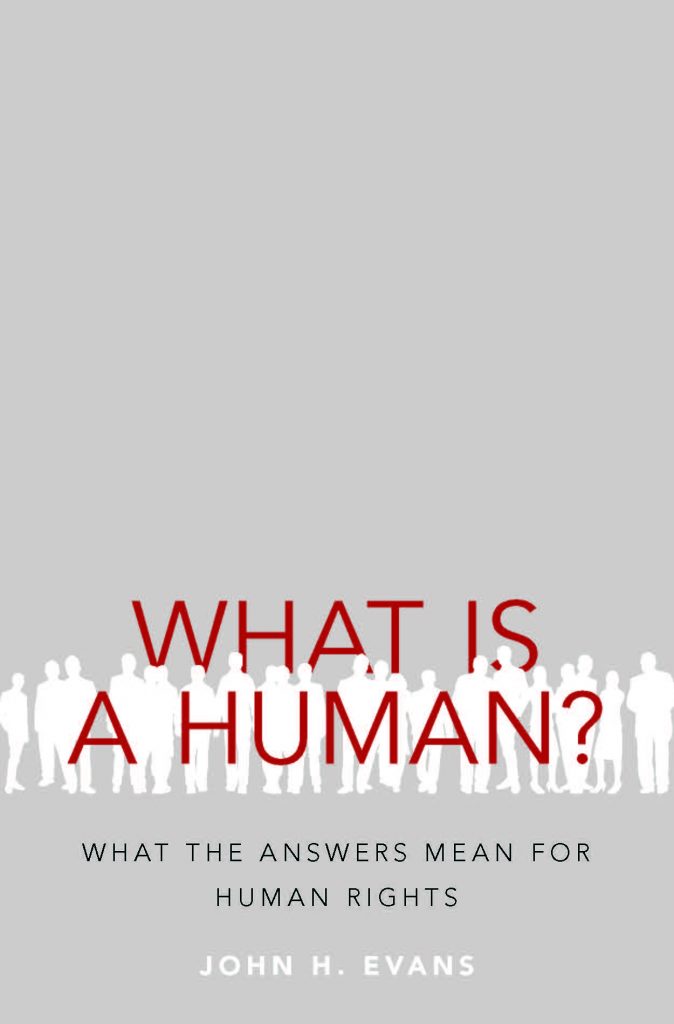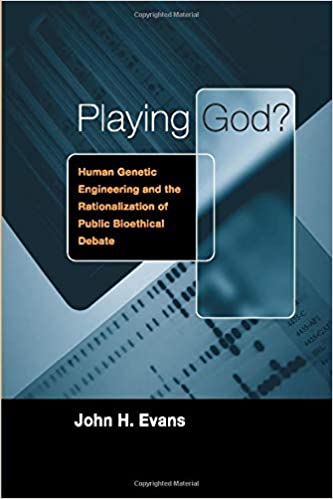
Disembodied Brains: Understanding Our Intuitions on Neuro-Chimeras and Human-Brain Organoids
The development of human-animal neuro-chimeras, which are animals with some component of a human brain, plays into society’s long-standing fascination with the crossover between humans and animals. In the same way, the development of human brain organoids-small parts of a human brain grown from harvested human cells-feeds our fear and fascination of disembodied brains. The general reaction to these technologies is shock or disgust. This book closely examines the public’s response to these new scientific advances.

In 2018 the first genetically modified babies were reportedly born in China, made possible by the invention of CRISPR technology in 2012. This controversial advancement overturned the pre-existing moral consensus, which had held for over fifty years before: while gene editing an adult person was morally acceptable, modifying babies, and thus subsequent generations, crossed a significant moral line. If this line is passed over, scientists will be left without an agreed-upon ethical limit. What do we do now?
John H. Evans here provides a meta-level guide to how these debates move forward and their significance to society. He explains how the bioethical debate has long been characterized as a slippery slope, with consensually ethical use at the top, nightmarish dystopia at the bottom, and specific agreed-upon limits in between, which draw the lines between the ethical and the unethical. Evans frames his analysis around these limits, or barriers. Historically they have existed to guide scientists and to prevent the debate from slipping down the metaphorical slope into unacceptable eugenicist possibilities, such as in Aldous Huxley’s novel Brave New World or the movie Gattaca. Evans examines the history of how barriers were placed, then fell, then replaced by new ones, and discusses how these insights inform where the debate may head. He evaluates other proposed barriers relevant to where we are now, projects that most of the barriers suggested by scientists and bioethicists will not hold, and cautiously identifies a few that could serve as the moral boundary for the next generation. At a critical time in this new era of intervention in the human genome, The Human Gene EditingDebate provides a necessary, comprehensive analysis of the conversation’s direction, past, present, and future.

Morals Not Knowledge: Recasting the Contemporary U.S. Conflict Between Religion and Science
In a time when conservative politicians challenge the irrefutability of scientific findings such as climate change, it is more important than ever to understand the conflict at the heart of the “religion vs. science” debates unfolding in the public sphere. In this groundbreaking work, John H. Evans reveals that, with a few limited exceptions, even the most conservative religious Americans accept science’s ability to make factual claims about the world. However, many religious people take issue with the morality implicitly promoted by some forms of science. Using clear and engaging scholarship, Evans upends the prevailing notion that there is a fundamental conflict over the way that scientists and religious people make claims about nature and argues that only by properly understanding moral conflict between contemporary religion and science will we be able to contribute to a more productive interaction between these two great institutions.

What is a Human? What the Answers Mean for Human Rights
What is a human? Are humans those with human DNA, those in possession of traits like rationality, or those made in the image of God? The debate over what makes human beings unique has raged for centuries. Many think that if society accepts the wrong definition of what it is to be human, people will look at their neighbor as more of an animal, object, or machine-making maltreatment more likely. In the longest running claim, for over 150 years critics have claimed that taking a Darwinist definition results in people treating each other more like animals.
Despite their seriousness, these claims have never been empirically investigated. In this groundbreaking book John H. Evans shows that the definitions promoted by biologists and philosophers actually are associated with less support for human rights. Members of the public who agree with these definitions are less willing to sacrifice to stop genocides and are more supportive of buying organs from poor people, of experimenting on prisoners against their will, and of torturing people to potentially save lives. It appears that the critics are right.
However, Evans finds that few Americans agree with these academic definitions. Looking at how most of the public defines humanity, we see a much more nuanced picture. In a fascinating account, he shows that the dominant definitions are unlikely to lead to human rights abuses. He concludes that the critics are right about the definitions of a human promoted by academic biologists and philosophers, and are therefore justified in their vigilance. However, because at present few Americans agree with these definitions, the academic definitions would have to spread much more extensively before impacting how the general public acts. Evans’ book is a major corrective to the more than century-long debate about the impact of definitions of a human.

The History and Future of Bioethics
It seems like every day society faces a new ethical challenge raised by a scientific innovation. Human genetic engineering, stem cell research, face transplantation, synthetic biology – all were science fiction only a few decades ago, but now are all reality. How do we as a society decide whether these technologies are ethical? For decades professional bioethicists have served as mediators between a busy public and its decision-makers, helping people understand their own ethical concerns, framing arguments, discrediting illogical claims, and supporting promising ones. These bioethicists play an instrumental role in guiding governments’ ethical policy decisions, consulting for hospitals faced with vital decisions, and advising institutions that conduct research on humans.
Although the bioethics profession has functioned effectively for many years, it is now in crisis. Policy-makers are less inclined to take the advice of bioethics professionals, with many observers saying that bioethics debates have simply become partisan politics with dueling democratic and republican bioethicists. While this crisis is contained to the task of recommending ethical policy to the government, there is risk that it will spread to the other tasks conducted by bioethicists.
To understand how this crisis came about and to arrive at a solution, John H. Evans closely examines the history of the bioethics profession. Bioethics debates were originally dominated by theologians, but came to be dominated by the emerging bioethics profession due to the subtle and slow involvement of the government as the primary consumer of bioethical arguments. After the 1980s, however, the views of the government changed, making bioethical arguments less legitimate. Exploring the sociological processes that lead to the evolution of bioethics to where it is today, Evans proposes a radical solution to the crisis. Bioethicists must give up its inessential functions, change the way they make ethical arguments, and make conscious and explicit steps toward re-establishing the profession’s legitimacy as a mediator between the public and government decision-makers.

Contested Reproduction: Genetic Technologies, Religion and Public Debate
Scientific breakthroughs have led us to a point where soon we will be able to make specific choices about the genetic makeup of our offspring. In fact, this reality has arrived—and it is only a matter of time before the technology becomes widespread.
Much like past arguments about stem-cell research, the coming debate over these reproductive genetic technologies (RGTs) will be both political and, for many people, religious. In order to understand how the debate will play out in the United States, John H. Evans conducted the first in-depth study of the claims made about RGTs by religious people from across the political spectrum, and Contested Reproduction is the stimulating result.
Some of the opinions Evans documents are familiar, but others—such as the idea that certain genetic conditions produce a “meaningful suffering” that is, ultimately, desirable—provide a fascinating glimpse of religious reactions to cutting-edge science. Not surprisingly, Evans discovers that for many people opinion on the issue closely relates to their feelings about abortion, but he also finds a shared moral language that offers a way around the unproductive polarization of the abortion debate and other culture-war concerns. Admirably evenhanded, Contested Reproduction is a prescient, profound look into the future of a hot-button issue.

Playing God? Human Genetic Engineering and the Rationalization of Public Bioethical Debate
Technology evolves at a dazzling speed, and nowhere more so than in the field of genetic engineering, where the possibility of directly changing the genes of one’s children is quickly becoming a reality. The public is rightly concerned, but interestingly, they have not had much to say about the implications of recent advancements in human genetics.
Playing God? asks why and explores the social forces that have led to the thinning out of public debate over human genetic engineering. John H. Evans contends that the problem lies in the structure of the debate itself. Disputes over human genetic engineering concern the means for achieving assumed ends, rather than being a healthy discussion about the ends themselves. According to Evans, this change in focus occurred as the jurisdiction over the debate shifted from scientists to bioethicists, a change which itself was caused by the rise of the bureaucratic state as the authority in such matters. The implications of this timely study are twofold. Evans not only explores how decisions about the ethics of human genetic engineering are made, but also shows how the structure of the debate has led to the technological choices we now face.
